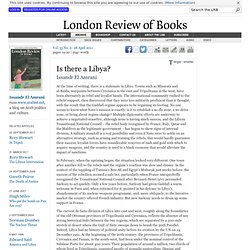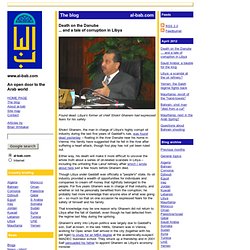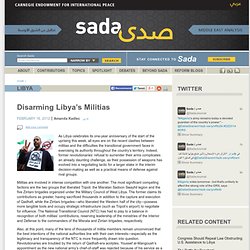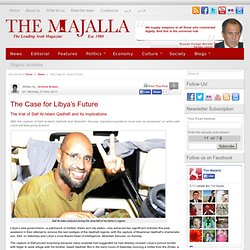

Libyan democracy hijacked. Nothing is going to plan in Libya.

Issandr El Amrani · Is there a Libya? · LRB 28 April 2011. At the time of writing, there is a stalemate in Libya.

Towns such as Misurata and al-Baida, waypoints between Cyrenaica in the east and Tripolitania in the west, have been alternately in rebel and loyalist hands. The international community rushed to the rebels’ support, then discovered that they were less militarily proficient than it thought, with the result that the Gaddafi regime appears to be regaining its footing. No one seems to know what Nato’s mission is exactly: is it to establish a no-fly zone, a no-drive zone, or bring about regime change?
Multiple diplomatic efforts are underway to achieve a negotiated ceasefire, although none is having much success, and the Libyan Transitional National Council – the rebel body recognised by France, Italy, Qatar and the Maldives as the legitimate government – has begun to show signs of internal division. The Libyan Rorschach - By Sean Kane. Using a bright blue pen, the young man behind the cash register in the kebab shop on the outskirts of Tripoli began to methodically scratch out the face of Muammar al-Qaddafi from his stack of one-dinar notes.

About halfway through the pile, he greeted a bill that had already been defaced with a happy nod and smile of satisfaction. After exhausting the one-dinar notes he turned to the 20s, and began surgically excising a miniature Brother Leader from a summit group photo. Prior to February 17, 2011 everything in Qaddafi's Great Socialist People's Libyan Arab Jamahiriya was physically painted a shade of light green to symbolize the political system of stateless government laid out in the Brother Leader's Green Book.
Adam Curtis Blog: HE'S BEHIND YOU. The Gadhafi Regime. Where the Streets Have New Names. Just like the other revolutionary countries – most notably Egypt but also Tunisia, Bahrain, Syria and others – Libya has seen an explosion in street art.

Under Gaddafi, neither political opposition nor independent cultural expressions were tolerated. Graffiti pieces like those you can see all over the streets today – mocking Gaddafi, celebrating the Libyan people – were unthinkable. Mashallah has put together a gallery with some of the street art of post-Gaddafi Libya. The photographs were taken in Benghazi, Tripoli and Misrata during February and March. This mural can be seen next to the historical arch in Tripoli’s Old City. Hands breaking free from chains, birds flying towards the sky, graffitied graffiti. Two other paintings decorating walls in Tripoli’s Old Town. “The random firing of bullets scares us” says this mural in central Tripoli.
Death on the Danube. Death on the Danube ... and a tale of corruption in Libya Found dead: Libya's former oil chief Shokri Ghanem had expressed fears for his safety Shokri Ghanem, the man in charge of Libya's highly corrupt oil industry during the last five years of Gaddafi's rule, was found dead yesterday – floating in the river Danube near his home in Vienna.

His family have suggested that he fell in the river after suffering a heart attack, though foul play has not yet been ruled out. Either way, his death will make it more difficult to uncover the whole truth about a series of oil-related scandals in Libya – including the unfolding Ras Lanuf refinery affair which I wrote about here just a few hours before Ghanem died. Though Libya under Gaddafi was officially a "people's" state, its oil industry provided a wealth of opportunities for individuals and companies to cream off money that rightfully belonged to the people. Ghanem's entry into Libyan politics was largely due to Gaddafi's son, Saif al-Islam. 1. Former Qaddafi Mercenaries Describe Fighting in Libyan War - Peter Gwin - International.
Hundreds, perhaps thousands, of ethnic Tuaregs left Mali to fight for Muammar Qaddafi.

Now, some are returning home to tell their story Tuareg mercenaries, like the above pictured Niger-based fighters, have been reported fighting for Qaddafi in Libya / Reuters TIMBUKTU, Mali -- Last month at a guesthouse within sight of the rolling dunes of the open Sahara, I sat down to await one of Muammar Qaddafi's mercenaries. Through an intermediary he agreed to meet and explain why the Tuareg -- an ancient Saharan people who inhabit large desert swathes of Libya, Mali, Niger, and Algeria -- would help the Libyan leader crush the democracy protests -- including unarmed civilians, women, and children -- and eventually join in all-out war against the ensuing rebellion I learned about him when a Tuareg elder told me that in recent weeks more than 200 Tuareg fighters had returned from Libya to Timbuktu and the surrounding villages.
The Libyan Model? In the halls of the United Nations (UN) in New York, “Libya” hangs like an ellipse.

For some, the word connotes a successful agenda for humanitarian intervention. For others, it suggests a disaster. Impending wars in West Asia remain spurred on, or haunted, by “Libya.” Oil traders downplay the dangers of a strike on Iran. They point out that any shortfall in oil markets will be covered by “friendly” oilfields in Iraq and Libya, as well as by the Saudi regime’s eagerness to pump more oil to maintain supply at current levels.
Libya - resources. Libya - reading... Libya - curators... Lacher on the Social Bases of Activity in the Libyan Revolution. The Current Political Situation in Libya: An Interview with Ali Ahmida. Libya is back in the news with increasing tensions among various militia groups and political factions struggling for power, sometimes through street battles.

Disarming Libya’s Militias. As Libya celebrates its one-year anniversary of the start of the uprising this week, all eyes are on the recent clashes between militias and the difficulties the transitional government faces in exercising its authority throughout the country’s territory.

Indeed, former revolutionaries’ refusal to surrender their arms complicates an already daunting challenge, as their possession of weapons has evolved into a negotiating tactic for a larger stake in the interim decision-making as well as a practical means of defense against rival groups. Militias are involved in intense competition with one another. The most significant competing factions are the two groups that liberated Tripoli: the Misratan Sadoon Swayhil legion and the five Zintani brigades organized under the Military Council of West Libya.
But there are also many positive signs. Furthermore, the new Libyan government must also establish a respected legal and judicial system capable of enforcing a weapons reduction plan. عربي. The Case for Libya’s Future. The trial of Saif Al-Islam Qadhafi and its implications With the capture of Saif al-Islam Qadhafi and Abdullah Senussi, important questions must now be answered on what path Libya will take going forward.

Saif Al-Islam pictured during the downfall of his father's regime Libya’s new government—a patchwork of militias, tribes and city states—has achieved two significant victories this past weekend in their attempt to remove the last vestiges of the Qadhafi regime, with the capture of Muammar Qadhafi’s charismatic son, Saif, on Saturday and Libya’s once feared head of intelligence, Abdullah Senussi, on Sunday. The capture of Saif proved surprising because many analysts had suggested he had already crossed Libya’s porous border with Niger to seek refuge with his brother, Saadi Qadhafi.
Captive The visibly frightened and wounded Qadhafi put up no resistance and was transported by plane to Zintan.